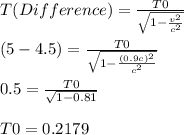
Physics, 07.06.2020 03:00 artsycentury
Light requires 4.5 years to travel from the nearest star to earth. If we could travel there in a spaceship going 90% of the speed of light, the trip would require 5.0 years according to clocks on earth. How much time would pass for the passengers in the ship

Answers: 1


Another question on Physics

Physics, 22.06.2019 01:30
Question 7 [2 marks] in the circuit below, the electromotive force generated by the battery is e = 6.0 v, and the resistances are r1 = r4 = 1.0 q, r2 = r3 =2.0 q. r. the power delivered by the battery to the circuit is closest to a. 6 w в. 12 w с. 15 w d. 18 w e. 20 w final exam autumn 2014 page 5 of 9 68037 physical modelling faculty of science [2 mark] question 8 with reference to question 7, the current through resistor r2 is closest to a. 1 a в. 2 а c. 3 a d. 4 a e. 6 a
Answers: 2

Physics, 22.06.2019 03:30
Using a wheel and axle, a farmer is trying to lift a bucket of water from the bottom of a well. the larger wheel has a radius of 40 cm compared to the axle that has a radius of 10 cm. if a bucket of water is 50 n, then how much effort is required to raise it? 12.5 n 200 n 2 n 500 n
Answers: 1

Physics, 22.06.2019 19:00
Review multiple-concept example 7 in this chapter as an aid in solving this problem. in a fast-pitch softball game the pitcher is impressive to watch, as she delivers a pitch by rapidly whirling her arm around so that the ball in her hand moves in a circle. in one instance, the radius of the circle is 0.626 m. at one point on this circle, the ball has an angular acceleration of 66.1 rad/s2 and an angular speed of 12.6 rad/s. (a) find the magnitude of the total acceleration (centripetal plus tangential) of the ball. (b) determine the angle of the total acceleration relative to the radial direction.
Answers: 3

Physics, 22.06.2019 20:40
Abasketball star covers 2.65 m horizontally in a jump to dunk the ball. his motion through space can be modeled precisely as that of a particle at his center of mass. his center of mass is at elevation 1.02 m when he leaves the floor. it reaches a maximum height of 1.90 m above the floor and is at elevation 0.910 m when he touches down again. (a) determine his time of flight (his "hang time"). (b) determine his horizontal velocity at the instant of takeoff. (c) determine his vertical velocity at the instant of takeoff. (d) determine his takeoff angle. (e) for comparison, determine the hang time of a whitetail deer making a jump with center-of-mass elevations yi = 1.20 m, ymax = 2.45 m, and yf = 0.750 m.
Answers: 1
You know the right answer?
Light requires 4.5 years to travel from the nearest star to earth. If we could travel there in a spa...
Questions


History, 24.10.2020 04:30


Mathematics, 24.10.2020 04:30

History, 24.10.2020 04:30

Mathematics, 24.10.2020 04:30


Mathematics, 24.10.2020 04:30

Mathematics, 24.10.2020 04:30

Chemistry, 24.10.2020 04:30






History, 24.10.2020 04:30

History, 24.10.2020 04:30

Biology, 24.10.2020 04:30





